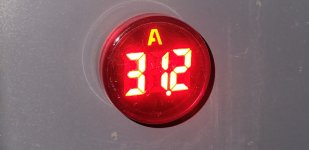Hey there guys, so I've been on the hunt for a panel gauge that I can install in enclosures that was small, preferably using a round hole, and be affordable. As some of the panel gauges I had installed for customers over the years were getting into the several hundred-dollar range and required punching out a huge hole. I wanted something more efficient, something a guy could afford to put on like every motor.
Well I found just what I was looking for, I'll attach pictures, found them surfing the web and they check off all the marks. Uses a 22mm hole, standard size perfect. 0 to 100 amps, huge range I'll never need them for more than 100. Digital, no more analog and squinting to see where the gauge is at. And stupid cheap, which probably should have been my red flag, but I was really excited to give them a try.
I installed a few and they work, like really well, against my Klein meter within an amp, good enough for where they're going. And really bright, can be read from a distance. Was going to install another and said hold up...where's the UL listing, where's any NRTL mark? It's tagged for CE, but that's not accepted by OSHA as far as their website says at the moment.
So now I'm conflicted, these things are just what the doctor ordered, but it kind of looks like I might not be able to use them. Maybe you guys have seen or even used these things before.... what do you think...use them or pitch them in the trash? Thanks.
Well I found just what I was looking for, I'll attach pictures, found them surfing the web and they check off all the marks. Uses a 22mm hole, standard size perfect. 0 to 100 amps, huge range I'll never need them for more than 100. Digital, no more analog and squinting to see where the gauge is at. And stupid cheap, which probably should have been my red flag, but I was really excited to give them a try.
I installed a few and they work, like really well, against my Klein meter within an amp, good enough for where they're going. And really bright, can be read from a distance. Was going to install another and said hold up...where's the UL listing, where's any NRTL mark? It's tagged for CE, but that's not accepted by OSHA as far as their website says at the moment.
So now I'm conflicted, these things are just what the doctor ordered, but it kind of looks like I might not be able to use them. Maybe you guys have seen or even used these things before.... what do you think...use them or pitch them in the trash? Thanks.



